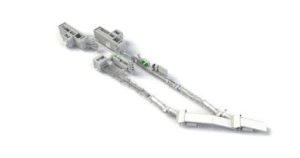Baked goods are constantly on the move after leaving the oven. And just like during an ordinary trip, there might be pitfalls: mechanical stress can cause the sensitive structures to break, leading to product loss. Avoiding those risks calls for advanced handling and picking technology that equipment manufacturers like Syntegon are ready to provide. Their innovations not only allow for product-specific gentle handling, but also for automated processes. Read on to find out how the technologies’ seamless interplay makes for a safe and efficient product journey.
The journey of most baked goods takes them across conveyor belts to primary and secondary packaging equipment. This is where potential damage can occur – and where Syntegon’s magic happens. Due to their brittle structure, cookies, cakes, crackers and biscuits should be exposed to mechanical stress as little as possible. Keeping transport distances between the oven and the packaging process short is one way of reaching this goal. After all, the longer the way to a flow wrapper or traying machine, the bigger the risk of breakage becomes. Another way is to rely on gentle handling solutions that minimize abrasion, and hence product breakage and waste.
From the oven to the packaging leg
Depending on the product quantities, Syntegon offers different solutions for this crucial first step. Especially for small to medium outputs, the Intelligent Direct Handling (IDH) is a perfect fit. Launched in 2022, Syntegon’s flexible pick-and-place machine with linear motors has been designed for handling and portioning cookies and crackers. The technology’s special drives not only ensure particularly gentle product handling, but also offer a compact design that keeps distances short. The solution offers manufacturers the option of loading different products in trays and flow-wraps. And here’s how it works: with a nominal 30 cycles per minute, the up to 40 pickers of the IDH’s linear motor bar pick the products from the process belt and place them into a flow- wrapper infeed or into trays.
When larger product quantities are at play, the first part of the products’ journey asks for a different approach – the Distribution Continuous Slide (DCS). The high-performance discharge station consists of a conveyor system which gently transports baked goods to the production line’s packaging legs, hence reducing mechanical stress. Its special design makes this possible: fragile products are neither dropped nor pushed but simply slide over belts. The DCS arranges the straight product stream into an S-shape to avoid product build-up on the packaging leg and to ensure that cookies or crackers are evenly distributed across the entire width of the belt. This in turn ensures a smooth product infeed to the packaging machine.
In terms of gentle handling, Syntegon has set new standards with the Distribution Continuous Gentle (DCG). The efficient modular solution consists of one or more stations that can be arranged one behind the other. With the help of a pullnose, the DCG discharge belt lowers and deposits products, such as fragile cakes gently and in a controlled manner onto the downstream cross belt at a rate of 400 sliced cakes at 18 cycles per minute. The baked goods are neither dropped nor pushed. In addition, the distribution station’s open design makes it easily accessible. Sloped surfaces help catch product residue and keep the production environment clean. Just like the DCS, this latest development minimizes mechanical stress and avoids product loss as well.
The next process steps, such as flow wrapping or traying, are all about effortless transitions and efficient product placing: infeed modules link handling solutions to packaging equipment. They should help avoid product build-up on the line and continuously feed products to e.g., flow wrapping machines. This is where infeed solutions with linear technology come into play. Syntegon’s FIT module, for instance, allows each mover of the infeed belt to be controlled individually and to accelerate once it has safely captured a product. In doing so, the infeed prevents products from coming into contact with each other before they are wrapped into their protective films.
Robots for secondary packaging
Flow-wrapped individual products don’t hit shelves immediately. Instead, they are often grouped and loaded into secondary packaging, usually cartons in varying shapes and sizes. Loading singular products into the protective casings is the job of robotic pick-and-place (RPP) solutions, which Syntegon has crafted to great efficiency. Often aided by camera systems, the robots automatically inspect the incoming products, discharge defectively packaged ones and group the rest of the products for endloading into secondary packaging. Specially designed End-of-Arm-tools (EoA) ensure that this process happens gently with minimal mechanical stress. Manufacturers achieve best results when they opt for integrated equipment, so that the speed of the robots can be synchronized with the speed of the cartoner’s infeed chain – for perfect endloading processes

Providing optimum pack style flexibility, the Syntegon DCS distributes cookies onto belt legs for packing them flat or on-edge into pile, slug or tray packs. It is equipped to handle fluctuating production volumes, triggered for example by the failure of a packaging leg, intelligently.

Discharge stations using belt slides ensure that biscuits or cookies slide smoothly over the belts – this protects from any mechanical stress.

Aided by integrated camera-based vision control systems, robots reliably detect various products in random order on the production belt.

Machines offering quick format changes and compatibility with different pack styles allow manufacturers to package a variety of baked goods.


